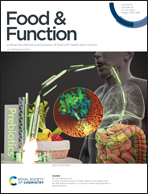Theaflavin: a natural candidate to restrain thrombosis†
Abstract
Many clinical studies have demonstrated the beneficial effects of black tea on cardiovascular diseases. However, the antiplatelet and antithrombotic activities of theaflavin (TF-1) remain unknown. In this study, we aimed to investigate the beneficial effects of TF-1 on platelet activation and thrombosis formation both in vitro and in vivo. Firstly, the in vitro antiplatelet activity of TF-1 was analyzed using platelets isolated from human blood via aggregometry, flow cytometry, the ELISA kit, western blot and fluorescence microscopy. Subsequently, the in vivo analysis of the hemostatic state and thrombosis formation was carried out in C57BL/6 mice based on the tail bleeding time and an FeCl3-induced arterial thrombus model. The results showed that TF-1 could prominently inhibit platelet aggregation in a dose-dependent manner, and attenuate P-selectin expression, fibrinogen binding, spreading and thromboxane A2 (TxA2) formation. Western blot analysis showed that TF-1 potently inhibited spleen tyrosine kinase (Syk) and Akt (ser473/474) phosphorylation. The in vivo data further confirmed the inhibition of platelet activation by TF-1 with a prolonged arterial occlusion time (from 15.0 ± 1.1 minutes to 40.0 ± 5.4 minutes). All the results indicated that TF-1 is a powerful inhibitor of platelet activation and thrombosis formation in C57BL/6 mice, and could be developed as a novel food-based inhibitor of thrombotic disorders.

- This article is part of the themed collection: Food & Function HOT Articles 2022


 Please wait while we load your content...
Please wait while we load your content...